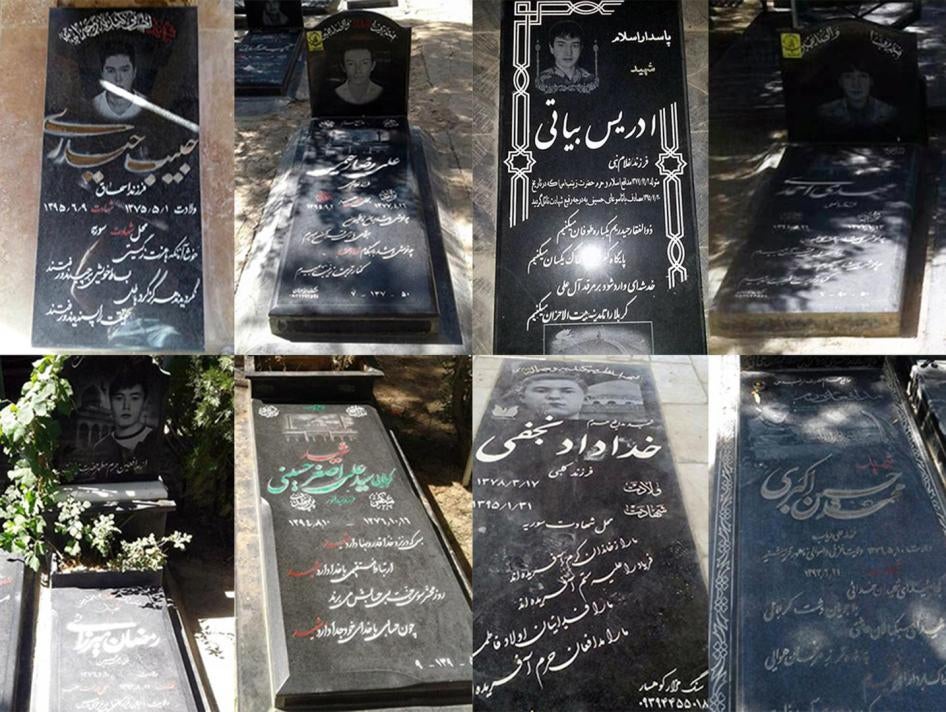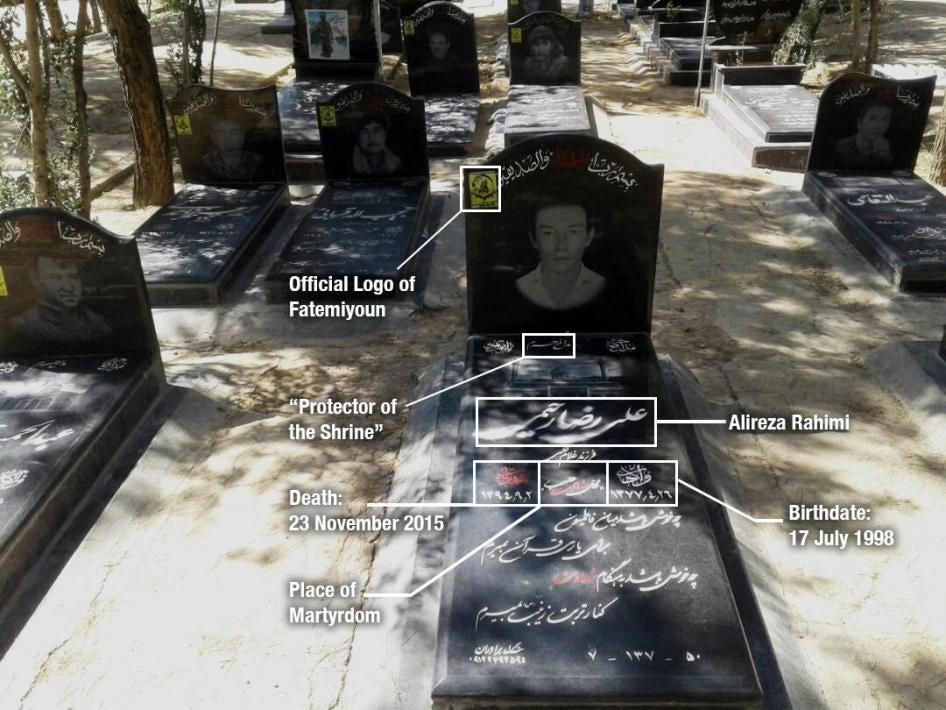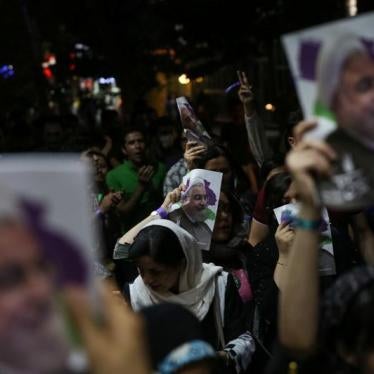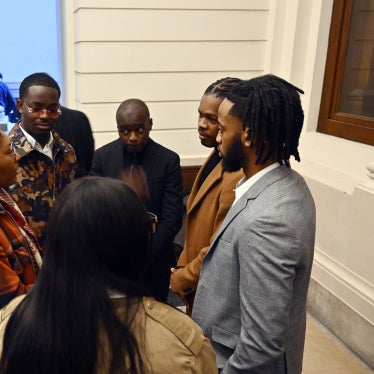(Beirut) – Iran’s Islamic Revolutionary Guards Corps (IRGC) has recruited Afghan immigrant children living in Iran to fight in Syria, Human Rights Watch said today. Afghan children as young as 14 have fought in the Fatemiyoun division, an exclusively Afghan armed group supported by Iran that fights alongside government forces in the Syrian conflict. Under international law, recruiting children under the age of 15 to participate actively in hostilities is a war crime.
Human Rights Watch researchers reviewed photographs of tombstones in Iranian cemeteries where the authorities buried combatants killed in Syria, and identified eight Afghan children who apparently fought and died in Syria. Iranian media reports also corroborated some of these cases and reported at least six more instances of Afghan child soldiers who died in Syria. For two of the reported cases, researchers reviewed photographs of tombstones that indicated the individual was over the age of 18, but family members of these deceased fighters told Iranian media that they were children who had misrepresented their age in order to join the Fatemiyoun division. This indicates that instances of Iran recruiting children to fight in Syria are likely more prevalent.
“Iran should immediately end the recruitment of child soldiers and bring back any Afghan children it has sent to fight in Syria,” said Sarah Leah Whitson, Middle East director at Human Rights Watch. “Rather than preying on vulnerable immigrant and refugee children, the Iranian authorities should protect all children and hold those responsible for recruiting Afghan children to account.”
In 2015, the Interior Ministry estimated that there were 2.5 million Afghans in Iran, many of them without residency papers. Human Rights Watch previously documented cases of Afghan refugees in Iran who “volunteered” to fight in Syria in the hopes of gaining legal status for their families.
Since 2013, Iran has supported and trained thousands of Afghans, at least some of them undocumented immigrants, as part of the Fatemiyoun division, a group that an Iranian newspaper close to the government describes as volunteer Afghan forces, to fight in Syria. In May 2015, Defa Press, a news agency close to Iran’s armed forces, reported that the Fatemiyoun had been elevated from a brigade to a division. There are no official public statistics on its size, but according to an interview published in the Revolutionary Guards-affiliated Tasnim News, it has about 14,000 fighters.
By reviewing photographs of their tombstones, Human Rights Watch documented eight Afghan children who fought and died in Syria. Five of them, one as young as 14, are buried in the Martyr’s Section of Tehran’s Behesht-e-Zahra cemetery. Writing on the epitaphs of the tombstones indicates that they were all probably killed in combat in Syria and that all of them were below the age of 18 at the time of their deaths. Human Rights Watch was able to document three more cases, of a 17-year-old, a 15-year-old, and another 17-year-old, who were buried in Alborz, Tehran, and Isfahan provinces, respectively.
In four of these cases, the tombstones also identified the children’s places of death in Syria, and in seven of the eight cases, the tombstones described the Afghan child as a “defender of the shrine,” the euphemism the Iranian government uses to describe fighters it sends to Syria. Domestic media reported their funerals and memorial services, along with their membership in the Fatemiyoun division and their place of “martyrdom” in Syria.
Domestic media reports also indicate that at least six more “defenders of the shrine” from the Fatemiyoun division are buried across the country and were under the age of 18 when they died. In two of these cases – Hassan Rahimi and Mohammad Zaman Atayi – information engraved on their tombstones indicated that the two were over 18 when they died, but media interviews with their families reveal that they were actually both children, or under 18, when they died fighting in Syria.
For instance, Isa Rahimi, the father of deceased Afghan child soldier Hassan Rahimi, told Iran’s Quran News Agency in November 2016, “On his tomb, his birthday is printed as 1995, but his real birthday is 1999. He had lied about his age so they would allow him to join the forces easier. They hadn’t asked him for a birth certificate, and that’s how he got away with it.”
Afghan fighters have also said they have seen children in training camps for Afghan forces. “Ali,” a 29-year-old Afghan, told Human Rights Watch in August that he talked to 16 and 17-year-old child soldiers who were being trained to fight in Syria. Ali said he joined the Fatemiyoun division after a recruiter approached him while he was trying to renew his residency permit at the Bureau for Aliens and Foreign Immigrants Affairs (BAFIA) office in a city outside Tehran. He said the recruiter told him he could get his permit if he joined up.
“They never asked me to show any documentation, but they wanted to make sure we were Afghan nationals,” Ali told Human Rights Watch. “We had to be above the age 18 to be recruited, but they only asked for our age, not any documentation.”
There is little transparency in Iran’s recruitment of soldiers to fight in Syria, including whether it has implemented measures to prevent child recruitment. On January 27, 2016, Mohsen Kazemeini, commander of the Tehran-based Mohammad Rasoul Allah division of the IRGC, said in a media interview that Basij paramilitary branches affiliated with the Revolutionary Guards are in charge of recruiting forces to fight in Syria. While Iran officially claims that all Afghans living in Iran who join the Fatemiyoun division are volunteers, the vulnerable legal position of many Afghan children living in Iran and their fear of being deported to Afghanistan may contribute to their decision to join up.
Authorities have attempted to extend rights to Afghan children living in Iran. In 2015, Iran reportedly allowed all Afghan children, including undocumented ones, to register for schools after Supreme Leader Ali Khamenei issued a ruling emphasizing that “no Afghan child, even the undocumented ones, should be left out of school.” Yet, this research demonstrates authorities have done too little to protect Afghan children from being recruited to fight in Syria, particularly in light of the fact that the government has proposed offering incentives such as a path to citizenship for families of foreign fighters who die, become injured, or are taken captive during “military missions.” These incentives without sufficient protections could increase the risk of child recruitment; as the United Nations High Commissioner for Refugees’ Executive Committee has emphasized, “refugee children and adolescents… are particularly vulnerable to recruitment by government armed forces…” and has called upon governments to implement policies to prevent this human rights violation.
Under the Rome Statute of the International Criminal Court, “conscripting or enlisting children under the age of 15 years into national armed forces or using them to participate actively in hostilities” is a war crime. Iran is not a party to the Rome Statute, but is bound by customary international law which also provides that recruitment of children under age 15 is a war crime.
The Optional Protocol to the Convention on the Rights of the Child on the involvement of children in armed conflict that entered into force on February 12, 2002, provides that 18 is the minimum age for direct participation in hostilities. Iran has signed the Optional Protocol, but the parliament has yet to vote on its ratification. Human Rights Watch has previously documented the use of child soldiers in the Syrian conflict by the People’s Protection Unit (YPG) – the Kurdish Democratic Union Party affiliate.
The UN should investigate child recruitment by the IRGC, and the secretary-general should consider adding the organization to his annual list of perpetrators of violations against children based on evidence of child recruitment, Human Rights Watch said.
“Iran should be improving protections for Afghan refugee children, not leaving them vulnerable to unscrupulous recruiting agents,” Whitson said. “Iran should immediately ratify the Optional Protocol and ensure that Afghan children are not being recruited to fight in Syria.”
Confirmed Cases of Child Soldiers (based on the writing on the epitaphs of the tombstones)
|
Name as engraved on tombstone |
Place of birth as engraved on tombstone |
Printed date of birth as engraved on tombstone |
Printed date of death as engraved on tombstone |
Printed place of death as engraved on tombstone |
Place of burial |
Age at the time death |
|
N/A |
July 17, 1998 |
November 23, 2015 |
Aleppo, Syria |
Tehran’s Behesht-e-Zahra Cemetery |
16-years-old |
|
|
Ghazni Province |
July 31, 2000 |
September 12, 2014 |
N/A |
Tehran’s Behesht-e-Zahra Cemetery |
14-years-old |
|
|
|
October 5, 1998 |
August 12, 2015 |
|
Tehran’s Behesht-e-Zahra Cemetery |
16-years-old |
|
|
|
March 30, 1997 |
November 13, 2014 |
Aleppo, Syria |
Tehran’s Behesht-e-Zahra Cemetery |
17-years-old |
|
|
|
January 6, 1998 |
November 1, 2015 |
|
Tehran’s Behesht-e-Zahra Cemetery |
17-years-old |
|
|
|
|
May 22, 2000 |
December 4, 2015 |
Palmyra, Syria |
Pakdasht Cemetery, Tehran Province
|
15-years-old |
|
|
June 7, 1999 |
April 19, 2016 |
Syria |
Sovojbolagh, Alborz Province
|
16-years-old |
|
|
|
February 21, 1999 |
October 11, 2016 |
|
Najaf Abad, Isfahan Province |
17-years-old |
Cases of Child Soldiers Reported in Iranian Media Outlets
|
Name |
Place of birth |
Printed date of birth |
Reported date of birth/reported age |
Date of death |
Place of death |
Place of burial |
|
|
July 22, 1996 |
17-years-old |
August 30, 2016 |
Sovjbolagh, Alborz Province |
||
|
|
|
16-years-old |
|
|
||
|
|
|
17-years-old |
|
|
Bumehen, Tehran Province |
|
|
|
March 20, 1996 |
March 20, 1996 (16-years-old) |
November 11, 2013 |
Syria |
Isfahan |
|
|
Qom |
1995 |
August 23, 1999 (16-years-old) |
December 24, 2015 |
Syria |
|
|
|
|
1993 |
17-years-old |
October 12, 2015 |
|
Shiraz |









